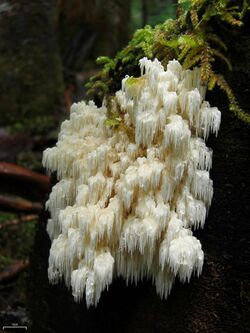Biology:Hericium abietis
| Hericium abietis | |
|---|---|

| |
| Scientific classification | |
| Domain: | Eukaryota |
| Kingdom: | Fungi |
| Division: | Basidiomycota |
| Class: | Agaricomycetes |
| Order: | Russulales |
| Family: | Hericiaceae |
| Genus: | Hericium |
| Species: | H. abietis
|
| Binomial name | |
| Hericium abietis (Weir ex Hubert) K.A.Harrison (1964)
| |
| Synonyms[1] | |
|
Hydnum abietis Weir ex Hubert (1931) | |
| Hericium abietis | |
|---|---|
| Mycological characteristics | |
| teeth on hymenium | |
| no distinct cap | |
| lacks a stipe | |
| spore print is white | |
| ecology is parasitic | |
| edibility: choice | |
Hericium abietis,[2] commonly known as the bear's head or the western coral hedgehog, is an edible mushroom in the tooth fungus group. It grows on conifer stumps or logs in North America, producing a cream white fruit body up to 10–75 cm (4–30 in) tall and wide. It fruits from after the start of the fall rains to mid-season.
Taxonomy
The species was first described as Hydnum abietis by American botanist James Robert Weir in 1931. Weir collected the type specimens in 1916, near the Priest River in Idaho. Kenneth Archibald Harrison transferred it to the genus Hericium in 1964.[3] The mushroom is commonly known as the "bear's head"[4] or the "western coral hedgehog".[5]
Description
The fruit body forms a compact, branched mass with long spines hanging down. The branches originate from a single, thick, tough base. The color of the fruit body ranges from white to creamy, light yellowish, to salmon-buff. The hanging spines are usually 0.5–1 cm (1⁄4–3⁄8 in) long, although some may be as long as 2.5 cm (1 in); they are soft and brittle, and typically grow as clusters at the tips of the branches. Typically, fruit bodies have dimensions in the range of 10 to 75 cm (4 to 30 in) tall and wide, but they have been known to attain massive sizes; one noted specimen was about 100 pounds (45 kg).[6]
Hericium abietis produces a white spore print. The spores are spherical or nearly so, smooth to slightly roughened, amyloid, and measure 4.5–5.5 by 4–5 μm.[6] The hyphae are monomitic (consisting of only generative hyphae), and they have clamp connections.[4]
Similar species
Hericium erinaceus is a lookalike spine fungus. It can be distinguished by its more compact fruit body structure that lacks multiple branches, in which the hanging spines all originate from a single thick tubercle.[4] In Hericium coralloides, the spines line the undersides of the branches, unlike H. abietis, whose spines are arranged in clusters at the tip of branches.[7]
Edibility
Hericium abietis is edible[8] and choice. David Arora suggests that cooking the mushroom produces a flavor similar to fish, and that it is suitable for sauteing, marinating, or preparing as a curry dish.[6]
Habitat and distribution
Hericium abietis causes a white rot of conifers; this is a form of wood decay featuring a selective attack on lignin and hemicellulose in wood.[4] The fruit bodies grow singly or occasionally in small groups on the dead wood of conifers, especially Douglas fir.[6] It can also be cultivated on conifer sawdust or logs.[9] The species is found throughout North America.[7]
References
- ↑ "Hericium abietis (Weir ex Hubert) K.A. Harrison 1964". MycoBank. International Mycological Association. http://www.mycobank.org/BioloMICS.aspx?Table=Mycobank&Rec=12792&Fields=All.
- ↑ Abietis, "of Abies", the fir genus.
- ↑ Harrison KA. (1964). "New or little known North American stipitate Hydnums". Canadian Journal of Botany 42 (9): 1205–33. doi:10.1139/b64-116.
- ↑ 4.0 4.1 4.2 4.3 Tylukti EE. (1987). Mushrooms of Idaho and the Pacific Northwest. Vol. 2 Non-gilled Hymenomycetes. Moscow, Idaho: The University of Idaho Press. pp. 139–40. ISBN 0-89301-097-9.
- ↑ McKnight VB, McKnight KH. (1987). A Field Guide to Mushrooms: North America. Peterson Field Guides. Boston, Massachusetts: Houghton Mifflin. p. 92. ISBN 0-395-91090-0. https://books.google.com/books?id=kSdA3V7Z9WcC&pg=PA92.
- ↑ 6.0 6.1 6.2 6.3 Arora D. (1986). Mushrooms Demystified: A Comprehensive Guide to the Fleshy Fungi. Berkeley, California: Ten Speed Press. p. 614. ISBN 0-89815-169-4. https://archive.org/details/mushroomsdemysti00aror_0/page/614.
- ↑ 7.0 7.1 Sundberg W, Bessette A. (1987). Mushrooms: A Quick Reference Guide to Mushrooms of North America. Macmillan Field Guides. New York, New York: Collier Books. p. 30. ISBN 0-02-063690-3.
- ↑ Meuninck, Jim (2017). Foraging Mushrooms Oregon: Finding, Identifying, and Preparing Edible Wild Mushrooms. Falcon Guides. p. 60. ISBN 978-1-4930-2669-2.
- ↑ Xiao GP, Chapman B. (1997). "Cultivation of Hericium abietis on conifer sawdust". Canadian Journal of Botany 75 (7): 1155–7. doi:10.1139/b97-827.
External links
- Hericium abietis in Index Fungorum
- Hericium abietis at mykoweb.com
Wikidata ☰ Q5738468 entry
 |


